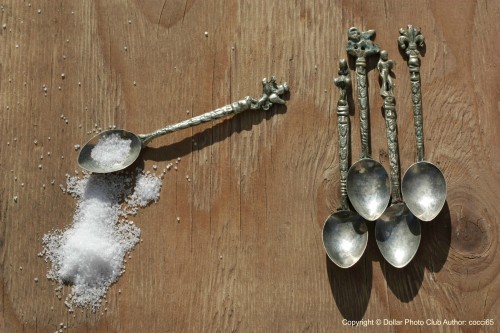Daily Added Sugar Recommendation for Kids: Three Teaspoons
Three teaspoons. That’s the amount of daily added sugar recommendation from the World Health Organization and the American Heart Association for children ages 4 to 8 years old to consume in a day*. Three teaspoons, in grams, is about 12 grams. One whole day…12 grams of added sugar. If you don’t regularly read nutrition labels then I can tell you that your child probably had at least this amount at breakfast alone. Shocking, right?
My husband and I have always considered ourselves to be pretty active, healthy people who eat a variety of foods and tend to make healthy choices. Over the course of our marriage, we have been blessed with three, healthy little girls. In the first few months of life, our second child was diagnosed with life threatening food allergies. This discovery threw me into the ring with her allergies…them against me and I wasn’t going to let them win. I researched recipes, bought crazy expensive food, navigated grocery store aisles that I didn’t even know existed and read nutrition labels like it was my job because, frankly, it was my job. It was my job to make sure that she was offered a well-balanced diet that wouldn’t harm her. Family functions were difficult, travel was ridiculous, attending parties required planning ahead with a mini-cooler in tow filled with items that she could have, should have, may want, may need.
Healthy Lifestyle
What was the outcome of years of living this way? I realized that our “healthy” lifestyle was far from healthy. Obsessing over nutrition labels and ingredients educated me in a way that I didn’t realize I needed educating. I realized that the majority of the food in our pantry, refrigerator and freezer was chemical ridden, calorie dense (or filled with empty calories), high sugar, and not nearly as nutritious as I had assumed.
Celebrating with Sugar
Do I deprive my children of treats? Of course not. Do they get cupcakes at birthday parties, Halloween candy, dessert every now and then after dinner, trips to the frozen yogurt shop, the occasional juice box? Absolutely. What I have noticed, though, is that our society celebrates so many life events (no matter how big or small) with sugar. A birthday in a classroom means donuts or cupcakes for the class (that equates to about 15 to 20+ days of extra sugar during the school year). Turn in enough Box Tops? Get a cupcake party for your class. Walk quietly to the bus line? Here’s a lollipop. Answer a question in class? Get a trip to the treasure box for a pack of Smarties. Add in Popsicles on the Playground, bake sales, sleepovers, Halloween, Thanksgiving, Christmas, Valentine’s Day, St. Patrick’s Day, and Easter and it’s easy to see that our kids are hyped up on sugary treats all year long.
Alternative to Sugar
The biggest challenge is finding an alternative to high sugar, empty calorie foods that our sweet little ones so love and crave. Many of these products are easily accessible and packaged in an oh so enticing way; even my two-year-old will attempt death-defying acts to get out of the grocery cart when she sees her favorite Disney character on a box of fruit snacks (which, of course, don’t have a single real fruit ingredient). At this point, I have come to terms with the fact that our kids will likely have far more sugar than I’m comfortable with, however, I can control what they consume at home and I can discuss alternative suggestions for rewards and celebrations with their teachers:
How about five minutes of extra recess?
A lunch date in the classroom with a friend?
A holiday coloring page to take home?
There are so many ways to cut back on the sugary offerings and, with enough creativity, the possibilities are endless! Allowing our children the opportunity to celebrate with small experiences rather than mindlessly eating candy sounds so dreamy, doesn’t it?
Sugar Addiction
There is overwhelming evidence that sugar, as addictive as cocaine, is a major contributor to our society’s obesity epidemic, cavities, behavior disorders, diabetes, cancer, and heart disease. Limiting our kids to three teaspoons of added sugar daily is, honestly, incredibly difficult but clearly, it is incredibly important. Life is all about balance. The only way we can find that balance is by educating ourselves, and getting a little creative with celebrations, rewards, and holidays. Imagine the lessons we can teach our children if we focus less on the pre-packaged, sugar-packed goodies, and more on highlighting their childhood with experiences and activity? If we make an effort to do this they might just discover that their bodies are to be taken care of, their minds need healthy nurturing and, perhaps most importantly, life itself is sweet.
*For preteens and teens, World Health Organization recommends five to eight teaspoons a day.
By Guest Blogger Chrissy McCullough
Want to see more blogs like this and also get notifications on local events and happenings? Subscribe to our free weekly newsletters.


Goodness – we have a lot of changes to make in our household! I agree with you that sweet treats are offered way too often, and it’s just as easy to offer something else that the kids will equally love. Another pet peeve of mine: offering kids sweet treats after a sports game. What is the need? Thank you for this!
Yes, Melissa, that’s another pet peeve of mine as well! Sending kids out to run around on a field for an hour only to hand them a sugary drink and a sugary treat afterward doesn’t make sense to me either
–Chrissy